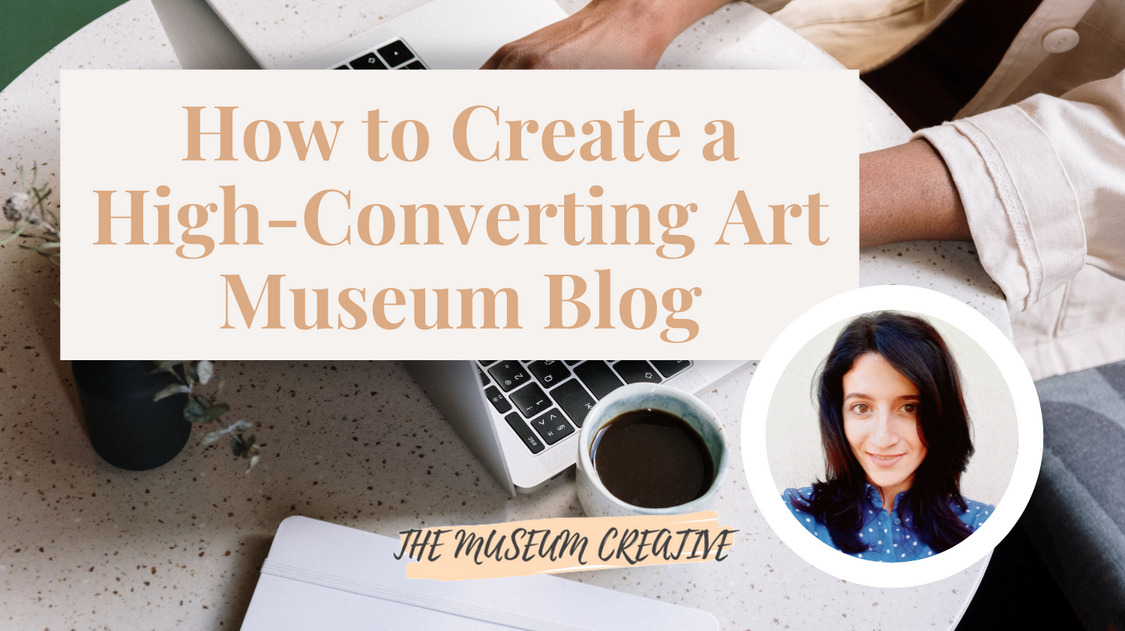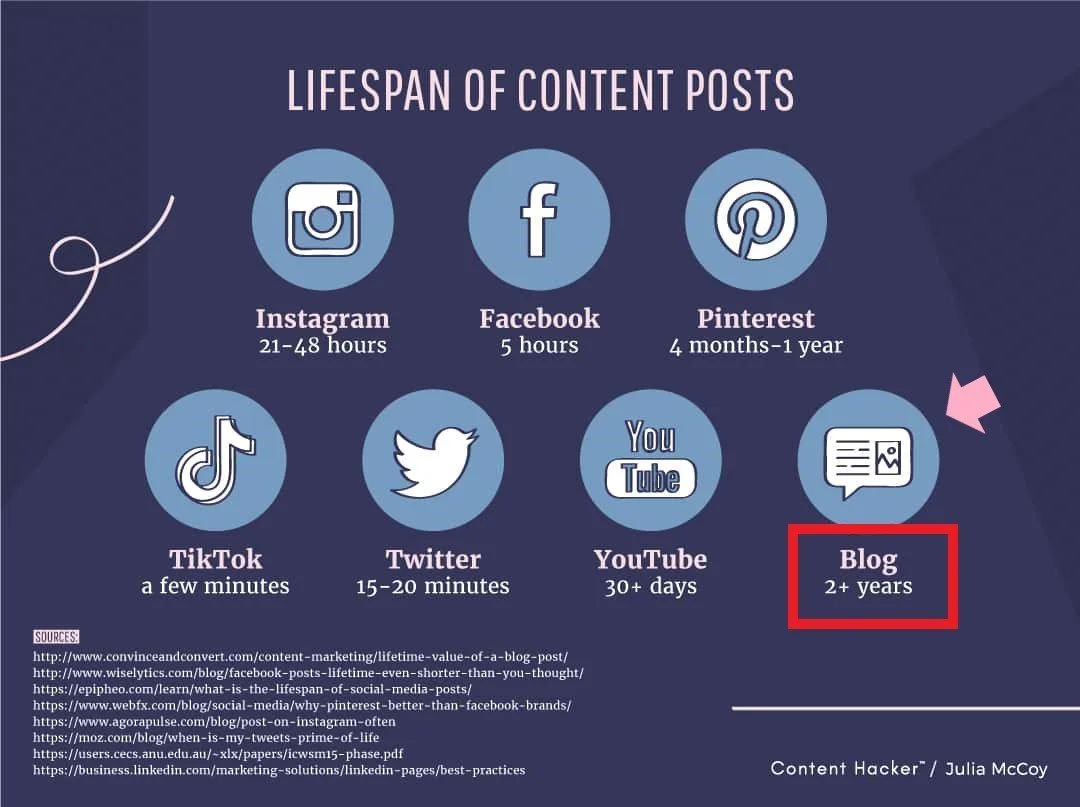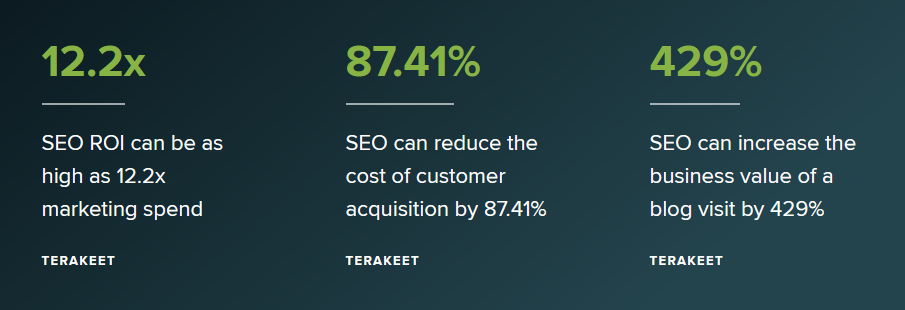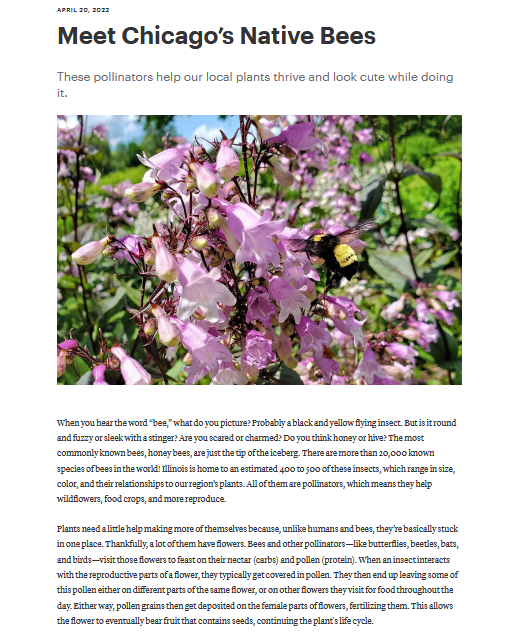How to Create a High-Converting Art Museum Blog
Facts: starting and maintaining a blog requires a great deal of effort and commitment.
Not knowing how to go about it, where to begin, what to write, or how to manage a publishing schedule can be a real hassle - so much so that you even question if a museum blog really matters.
Well, I’ve got great news for you!
With over 4.9 billion people connected to the internet, there’s never been a better time for businesses to start blogging - including museums!
Check this:
77% of internet users read blogs. (Social Media Today)
60% of people cite purchasing a product after originally reading a blog post about it. (Demand Metric)
77% of bloggers report that blogging drives results. (Orbit Media)
So, YES! A blog on your website makes all the difference in growing online and extending your reach.
It drives qualified web traffic, helps you promote your activities/services, boosts audience engagement, and, above all, nurtures trust with existing and prospective visitors.
All you need to do is build an effective blogging strategy that attracts more leads and gets people coming back to you repeatedly.
In today’s post, I’ll show you how to develop a high-converting art museum blog in seven key steps.
Let’s jump right in, shall we?
Art Museum Blog - Table of Contents
Writing an Art Museum Blog Will Benefit Your Institution Exponentially
7 Proven Tips to Write an Art Museum Blog That Converts (+ 1 Bonus Strategy)
Writing an Art Museum Blog Will Benefit Your Institution Exponentially
There’s no better way to increase your online visibility and brand recognition than doing consistent blog publishing.
With the right strategy, your art museum blog becomes a powerful tool to stand out - the more you share high-value evergreen content, the more chances you get to rank high in organic search and be found by your ideal audience.
Plus, Google rewards frequently updated content that answers users’ queries by pushing blog posts higher in the SERP.
This implies three things:
More traffic to your site.
More inbound leads.
More authentic connections.
Once you know how to write a museum blog, you have endless opportunities for success!
56% of marketers, who leverage blogging, say it's effective, and 10% say it generates the biggest return on investment. (HubSpot Blog Research, 2021)
This means that with a blog you’re able to:
Establish your brand’s voice, personality, and authority through educational content that engages your readers.
Make lasting connections with off-site visitors by giving them access to your collections, behind-the-scenes, events, and other exclusive content.
Build trust and strong customer relationships by meeting your audience’s needs and demands.
Creating and sharing content on your art museum blog is the most sustainable and profitable way to grow your digital presence - even more than social media!
Blog content has, in fact, the longest lifespan and the best longevity ever. It keeps performing through the years, improving your discoverability and positively influencing purchase processes over time.
The lifespan of content by type. (Content Hacker)
If you stay consistent, relevant, and on-mission with your blog, you’ll get amazing results!
Stick to your goals (Who’s your blog for? What’s its purpose? What do you want to get from it?) and focus on educational, entertaining content bound to help your audience.
7 Proven Tips to Write an Art Museum Blog That Converts (+ 1 Bonus Strategy)
Now that you know the benefits of writing an art museum blog, it’s time to discover the best ways to make the most of it.
The following seven tips will show you a tried-and-true method to writing blog posts that…
Grab users’ attention.
Get clicks.
Generate conversions.
Drive more sales.
The outcome?
Your content marketing efforts won’t be wasted - you'll be more productive in your blogging process and maximize the opportunity to market yourself successfully.
Also, make sure to read the post till the end for a bonus tip that will help increase your digital exposure, target new prospects, and set you apart from the numerous art blogs out there.
1. Understand Your Audience
Let me get this straight.
You can’t start writing your art museum blog if you don’t have a clear understanding of your target audience first.
Doing thorough audience research is the keystone of a high-converting blog.
Consider what you know about your ideal visitors, like their interests and needs, to define who they are and what they’re looking for. This way, you’ll come up with valuable content that resonates with them.
For instance, if your readers are millennials, you should approach them with digestible, compelling topics that meet their expectations of learning while having fun.
The Museum of Life + Science in Durham, NC, focuses its whole blog on science education and learning for young generations.
Dig deep into your research to find out what your audience would like to see on your blog; ask questions and talk with them to learn what they’d enjoy reading and share with others - their suggestions will bring great value to the process!
To go one step further, check your competition to get an insight into the content type other popular art museum websites are posting. (The goal isn’t to copy what they do but to take inspiration from them when brainstorming ideas.)
From the writing style and visuals of their posts to the topics their readers appreciate, you’ll learn A TON about how to create a quality blog that engages the audience.
2. Write An Outline
Along with picking topic ideas for your art museum blog, you need to create a content writing outline (aka the backbone of your art museum blog).
This step is essential to crafting a thoughtful, well-developed piece.
First, put together a list of the working title and key points to hit in your post; then, organize the content in separate paragraphs, each with its header and subheaders - this way, you’ll make your writing flow and have clarity on your content.
Your post should present the following:
Introduction: also known as the “hook”, it’s the most crucial part of a blog; it grabs the reader’s attention, triggers an emotional response, and entices them to keep reading.
Body sections: each of them is dedicated to a specific point, holding the reader’s interest.
Conclusion: it ends the post with a list of the main takeaways from the article and calls the reader to take action.
With a planned-out blogging outline, your research and writing process will increasingly speed up, ensuring your publications are valuable and consistent over time.
3. Optimize for SEO
SEO (Search Engine Optimization) strategies for your art museum blog are a surefire way to boost web traffic and attract new leads.
Look at these stats:
71% of bloggers say SEO is the most important source of traffic (Orbit Media).
Organic traffic from SEO is more than 1,000% higher than organic traffic from social media. (BrightEdge)
Screenshot from: Terakeet
Impressive, right?
Organic searches on Google bring great visibility to your website - more so when you create blog posts around focus keywords related to your niche and the audience’s search intent.
Let’s put it this way: if you provide readers with helpful, high-quality content that answers their questions, you stand every chance of ranking high on the SERP.
Keywords are extremely powerful in this sense. But mind using them naturally in your content as you write for your audience first.
For good content optimization, include the following:
Metadata.
Meta descriptions.
Headers.
Relevant images.
Length (1,500-2,500 words on average).
And most importantly, focus on value!
The more valuable information you give and effective your SEO strategy is, the more searchable your art museum blog will be, increasing engagement and brand exposure.
4. Make Your Content Skimmable
Clear, concise, skimmable content is everything.
If you aim to keep people visiting your art museum blog, steer clear of walls of text full of jargon and academic phrases - that’s a big turn-off for your readers!
While scrolling past, they’d feel intimidated by giant paragraphs to the point of skipping your post completely.
Break your article into digestible, short sections instead. Use bullet points, numbered lists, and subheadings (150-300 words each) to highlight your best information and make it easier to read.
Also, keep a conversational tone by switching to the second person and speaking directly to your audience.
Here’s what will happen:
Readers will absorb highly focused, quality information more quickly.
They’ll see that your post is worth their time.
You’ll improve your blog post’s readability score.
You’ll increase your SEO ranking and reach.
Look at two of the best museum blogs on the web to get a gist of what I mean:
The British Museum Blog
The article presents long chunks of text that make it hard to read. The tone is impersonal and academic, lacking emotion and empathy with the reader - this may work well in a research paper but not in a blog post!
The Field Museum Blog
This post has a different approach. It grabs the reader’s attention from the very first lines of the hook with a series of questions that make the tone more direct and personal. Subheaders and shortlists highlight key information, preventing reader fatigue.
5. Use Visuals
To boost audience engagement, start enhancing your art museum blog with appealing, relevant, high-quality images.
It’s scientifically proven the human brain processes visual content way faster than text-based content. So, why not use visuals to level up your blogging success?
Not only do they break up the text, giving your audience short breaks as they read through your post, but they also…
Help you support your ideas.
Bring the story to life in an engaging way.
Let readers visualize the points you’re making.
Improve your on-page SEO.
When possible, use personal photos and videos from your museum and art collections to deeply connect with your community and make the reading experience more interactive.
Also, add descriptive alt text to images so that…
Search engines will crawl and rank your post better.
The keywords included in the description will drive more traffic to your site.
Images will be more accessible as people learn about their content even when they can’t see them on the page.
Overall, a blog with visuals and other media will make the reading experience more enjoyable than a black-and-white piece of content.
6. Add a Clear CTA
Don’t end your art museum blog post without guiding readers to take action first.
An eye-catching, clear CTA (Call To Action) is the most effective way to do so.
Whether it’s an invitation to leave a comment, share your blog, follow you on social media, purchase tickets for an upcoming exhibit, subscribe to your membership, or join the newsletter, you need to emphasize what you’d like them to do.
The truth is that many museum blogs lack CTAs or don’t use them correctly - a problem common to over 70% of small businesses.
This means they’re missing out on a big opportunity to improve conversion rates by up to 121%!
Instead, by adding one specific CTA to your content - both at the end and within the text when it fits - you spur people to take the next steps in their marketing lifecycle journey.
Be wise about your calls to action - you don’t want to sound too pushy or salesy, as your purpose is to provide value and help.
This way, you’ll build an authentic relationship with your audience and easily get a jump on your competition.
7. Be Consistent
Posting articles regularly is one of the best investments you can make for your website’s long-term strength and authority.
Even with little budget, you can still rank high in search results and convert visitors into leads (marketers that prioritize blogging see 13-times the ROI of businesses that don't!).
All it takes is to stay consistent with your art museum blog.
Easier said than done, right?
But if you put the right strategy in place, you won’t struggle to maintain a steady publishing schedule.
Here’s what to do:
Frequently update your blog with fresh, high-quality content to boost your SEO and improve your page rankings.
Work on link building by including inbound and external links to valuable sources (other reputable sites could link back to you as well).
Publish relevant evergreen content to increase visibility and generate conversions.
Expand the number, variety, and range of keywords to rank for.
Create an editorial calendar to plan all your content ahead of time in a sustainable, low-stress way.
Outsource when needed to avoid burnout and ramp up your content creation.
Track your blog performance to streamline your strategy and increase your chances of success.
These insights set the foundation for a results-driven blog that sparks interest and leverages your brand reputation over time.
Bonus Tip: Create Lead Magnets for Your Art Museum Blog
Your secret weapon to generating more leads through your art museum blog is lead magnets.
Source: Coschedule
A good incentive, like an ebook, whitepaper, guide, video, template, or any other downloadable format, provides your audience with helpful, informative content that meets their needs and attracts them to click on it.
Integrating a lead magnet into your blog posts means delivering readers exclusive content accessible through a specific CTA.
Here’s how it works:
The CTA brings users to a landing page where they fill out a form with their contact information and email address; then, they land on a thank-you page to confirm their subscription to your newsletter and get their content piece in their inbox. At this point, they’ll receive an automated follow-up email from you to keep the conversation going.
Look at this practical example for more clarity (click on the image to access the related landing page):
Lots of benefits come from using lead magnets consistently. You’ll…
Grow your email list.
Connect with potential visitors/customers.
Enhance your conversion rates.
Show your expertise and value.
Develop trust and loyalty with your target audience.
Increase sales.
To optimize their performance, make sure they…
Answer a question or resolve a problem.
Deliver one quick win that fulfills your audience’s expectations.
Are instantly accessible to users.
Are educational, relevant, and to the point.
Are easy to digest.
Not only will you see a dramatic change in your conversion rates, but you’ll also stand out from most museums that are missing out!
An Art Museum Blog Is the Most Profitable Marketing Tool to Fuel Your Business Growth
Kudos! 👏
You now know how to write a blog for a museum that converts and drives long-term revenue.
Remember: with a strategic mindset, consistency, and patience, your art museum blog will slowly but surely work its way up in the search results.
Beyond bringing in web traffic, effective blogging will help you boost brand awareness, become a thought leader in your industry, attract qualified leads, and build strong relationships with your audience.
Quick takeaways:
The more you blog, the more visible your content gets in organic search.
There’s no better way to showcase your museum’s mission, values, and worth than through engaging, quality content.
Sticky essay writing isn’t fit for the web.
A content calendar lets you stick to your blogging plan and goals.
SEO, visuals, CTAs, and lead magnets are essential elements of a successful post.
A blog is a promising opportunity to scale. So, invest in it, commit, and put pen to paper. ✍️











